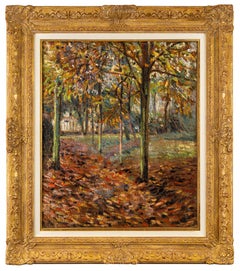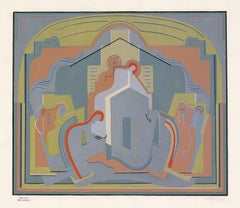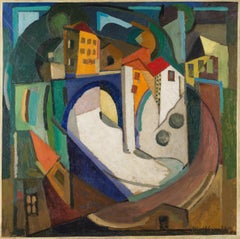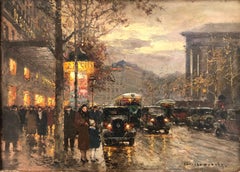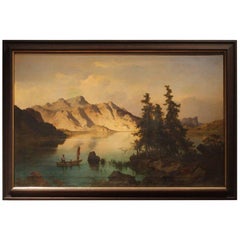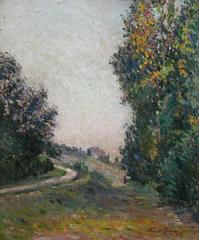Albert Gleizes Art
French, 1881-1953
Albert Gleizes (1881-1953) was a prominent French artist, theorist, and philosopher, best remembered as a pioneer of Cubism alongside artists like Picasso and Braque. Born in Paris, his early work was influenced by Impressionism, but by 1910, he had delved deep into the innovative world of Cubism, emphasizing geometrical forms and multiple viewpoints. With Jean Metzinger, he co-authored "On Cubism," a significant treatise that helped define and explain the movement's principles. Throughout his career, Gleizes continued to evolve his style, moving towards abstraction and integrating his fascination with rhythm and color. In addition to his visual contributions, his writings made him an influential voice in 20th-century art theory. A true visionary, Gleizes not only reshaped the art world with his creations but also laid the groundwork for future abstract artists with his profound insights into the essence of art.to
1
1
1
Overall Width
to
Overall Height
to
3
1
1
1
2
1
1
2
2
1
1
1
3
9,514
2,710
1,375
1,361
2
2
1
Artist: Albert Gleizes
Trees in Autumn
By Albert Gleizes
Located in Sheffield, MA
Albert Leon Gleizes
French, 1881-1953
Trees in Autumn
Oil on canvas
21 ¼ by 25 ½ in, w/ frame 30 ⅝ by 34 ¾ in
Signed lower right
This French painter and writer born Albert Leon Gle...
Category
Early 20th Century Impressionist Albert Gleizes Art
Materials
Oil
'Descente de Croix' (Descent from the Cross) — 1920s French Cubism
By Albert Gleizes
Located in Myrtle Beach, SC
Albert Gleizes, 'Descente de Croix', color pochoir, 1928, edition c. 50. Signed and dated in pencil. A fine, painterly impression, with fresh colors, on heavy, cream wove paper; the full sheet with margins (3 to 4 inches), in very good condition. The publisher's ink stamp 'EDITIONS MOLY-SABATA' beneath the image, lower left. Matted to museum standards, unframed.
Image size 12 x 14 inches (305 x 356 mm); sheet size 18 x 22 inches (457 x 559 mm).
ABOUT THE IMAGE
After the 1927 painting 'Descente de Croix', one of three religious-themed works that Gleizes developed as preliminaries for murals at the church at Serrières, France, the project was terminated at its final phase, and Gleizes commissioned master printer Robert Pouyaud to create prints of the paintings, closely overseeing the production.
ABOUT THE MEDIUM
Pochoir is a refined stencil-based technique employed to create multiples or to add color to prints produced in other mediums. Characterized by its crisp lines and rich color, the print-making process was most popular from the late 19th century through the 1930s, with its center of activity in Paris. The pochoir process began with the analysis of an image’s composition, including color tones and densities. The numerous stencils (made of aluminum, copper, or zinc) necessary to create a complete image were then designed and hand-cut by the 'découpeur.' The 'coloristes' applied watercolor or gouache pigments through the stencils, skillfully employing a variety of different brushes and methods of paint application to achieve the desired depth of color and textural and tonal nuance. The pochoir process, by its handcrafted methodology, resulted in the finished work producing the effect of an original painting, and in fact, each print was unique.
ABOUT THE ARTIST
Albert Gleizes (1881-1953), born in Paris, France, was a pioneering figure in the development of abstract art and one of the leading proponents of Cubism. His contributions to the art world extended beyond his paintings; he was also a prolific writer and theoretician, advocating for a new approach to art that emphasized the geometric abstraction of form and a departure from representational traditions.
Gleizes initially studied painting at the Académie Julian and the École des Beaux-Arts in Paris, where he was exposed to the academic conventions of the time. However, his artistic vision was profoundly influenced by encounters with avant-garde movements, including Fauvism and the work of Paul Cézanne. These influences led Gleizes to experiment with form and color, gradually moving away from traditional representation toward a more abstract and geometric style.
After completing his secondary schooling, Gleizes spent four years in the French army and then began pursuing a career as a painter, primarily doing landscapes. Initially influenced by the Impressionists, he was only twenty-one years of age when his work titled ‘La Seine à Asnières’ was exhibited at the Société Nationale des Beaux-Arts in 1902. The following year, he was part of the first Salon d'Automne and soon came under the influence of Fernand Léger, Robert Delaunay, Jean Metzinger, and Henri Le Fauconnier. In 1907, Gleizes and some of his friends pursued the idea of creating a self-supporting community of artists that would allow them to develop their art free of any commercial concerns. For nearly a year, Gleizes , with other painters, poets, musicians, and writers, lived at a large house in Créteil, but a lack of funds forced them to give up their facility in early 1908, and Gleizes moved temporarily into La Ruche, the artist commune in the Montparnasse Quarter of Paris.
In the early 1910s, Gleizes became associated with the Cubist movement, which was spearheaded by artists such as Pablo Picasso and Georges Braque...
Category
1920s Cubist Albert Gleizes Art
Materials
Stencil
Paysage
By Albert Gleizes
Located in London, GB
Mobilized in 1914, like many of his Cubist friends, Albert Gleizes was sent to a barracks in Toul, Lorraine, near the front line. Supported by a military doctor, Major Lambert, of wh...
Category
1910s Albert Gleizes Art
Materials
Canvas, Oil
Price Upon Request
Related Items
Boulevard de la Madeleine
By Édouard Leon Cortès
Located in Greenville, DE
Excellent example of Cortès Paris scene.
Provenance: Galerie Haussmann, Paris.Herbert Arnot, Inc., New York, New York (May 29, 1964).Country Store Gallery, Austin, Texas (February 2...
Category
Early 20th Century Impressionist Albert Gleizes Art
Materials
Oil, Canvas
J. Brunner 1869 Oil on Canvas Austrian Landscape with Lake and Mountain Painting
Located in Firenze, IT
This very fine quality 19th century oil on canvas in dark brown wood frame with gold leaves details throughout is signed by Joseph Brunner (Vienna 1826-...
Category
19th Century Romantic Albert Gleizes Art
Materials
Canvas, Wood, Oil
Joseph BrunnerJ. Brunner 1869 Oil on Canvas Austrian Landscape with Lake and Mountain Painting, 1869
$8,755
H 30.32 in W 43.31 in D 1.97 in
Italian 18th Century Oval Religious Oil on Canvas Painting with Saint Dominic
By Francesco de Mura
Located in Firenze, IT
This beautiful Italian 18th Century old masters oil painting on oval canvas with giltwood frame is attributed to Solimena and features a religious scene.
In this splendid oval-shaped painting are depicted Saint Dominic...
Category
18th Century Old Masters Albert Gleizes Art
Materials
Canvas, Oil
$13,014
H 21.66 in Dm 15.75 in
Moonlight and Mist
By Eliot Clark
Located in Greenville, DE
New York City artist Eliot Candee Clark was well known for his impressionist landscapes. He was the son of painter Walter Clark. Many of his paintin...
Category
Early 20th Century Impressionist Albert Gleizes Art
Materials
Oil, Canvas
Pablo Picasso, Jacqueline with Gauze, Daytime, Cutouts and Photographs, 1962
By Pablo Picasso
Located in Southampton, NY
This exquisite lithograph and stencil by Pablo Picasso (1881–1973), titled Jacqueline à l'étamine (Jacqueline with Gauze), originates from the 1962 folio Pablo Picasso, André Villers...
Category
1960s Cubist Albert Gleizes Art
Materials
Lithograph, Stencil
$796 Sale Price
20% Off
H 15.75 in W 11.75 in
New Castle Street Scene
Located in Greenville, DE
An excellent example of Doragh's best work. The scene is believed to be New Castle, Delaware circa 1920. The painting has been professionally restored. The ...
Category
1920s Impressionist Albert Gleizes Art
Materials
Canvas, Oil
CLAUDE MONET Style 19th CENTURY IMPRESSIONISM OLD MASTER OIL PAINTING
By (after) Claude Monet
Located in Ferndown, GB
OIL PAINTING Antique 19th Century Fine Quality Piece Gold Gilt frame
OLD MASTER OIL PAINTING BRITISH SCHOOL 19th Century in a Gold Frame
Description.
19th century Piece
“Good C...
Category
Mid-19th Century Impressionist Albert Gleizes Art
Materials
Oil
Pablo Picasso, The Bride as She Is, Daytime, Cutouts and Photographs, 1962
By Pablo Picasso
Located in Southampton, NY
This exquisite lithograph and stencil by Pablo Picasso (1881–1973), titled La mariée comme elle est (The Bride as She Is), originates from the 1962 folio Pablo Picasso, André Villers...
Category
1960s Cubist Albert Gleizes Art
Materials
Lithograph, Stencil
$796 Sale Price
20% Off
H 15.75 in W 11.75 in
Home Safe
By James Gale Tyler
Located in Greenville, DE
Very well executed seascape. Alternate title "In Point" inscribed on the rear. 17 x 15in in frame, including linen liner. ...
Category
Late 19th Century Impressionist Albert Gleizes Art
Materials
Oil, Board
Riverscape Impressionist Oil Painting by George Thompson Pritchard, Framed
By George Thompson Pritchard
Located in Encino, CA
Untitled Riverscape, an original oil on canvas by George Thompson Pritchard, is a piece for the true collector. An impressively calming nature of this plein-air painting draws you in...
Category
1930s Impressionist Albert Gleizes Art
Materials
Oil, Canvas
$8,000
H 31.375 in W 36.5 in D 2.25 in
'Agay, le château et le Sémaphore'. Oil on canvas. Signed.
By Armand Guillaumin
Located in Paris, FR
'Agay, le château et le Sémaphore'.
Oil on canvas. +/- 1922
Signed lower right
Measurements : 60 x 73 cm.
This painting will be recorded in the second volume of the Catalogue Raisonn...
Category
1920s Impressionist Albert Gleizes Art
Materials
Oil
$164,454
H 23.63 in W 28.75 in
VAN BIESBROECK Jules. Woman in a garden. Oil sketch on cardboard.
By Jules Pierre van Biesbroeck
Located in Paris, FR
Woman in a garden. Oil sketch on cardboard. Unsigned.
This work will be recorded in the catalogue raisonné of the work of the artist currently in preparation.
Jules Van Biesbroeck was the son of Jules Evariste van Biesbroeck, a painter of Ghent, but was born in Italy, in Portici, near Naples, while his parents were staying there. (In the 19th century many artists made educational trips to Italy). It was a long visit: the child was two years old by the time the family returned to Ghent.[1]
After a short period of practice with his father, van Biesbroeck was enrolled in the Academy of Fine Arts in Ghent. His first painting, "The Shepherd" (French: Le pâtre), was sold at the Triennale in Ghent. In 1888, when he was only 15 years old, he made his debut at the "Salon des Champs-Elysées" in Paris with his monumental work "The Launch of the Argo" (French: Le lancement...
Category
Early 20th Century Impressionist Albert Gleizes Art
Materials
Oil
$769
H 5.52 in W 3.15 in
Previously Available Items
Cubist Man etching 1946
By Albert Gleizes
Located in Long Island City, NY
Albert Gleizes was a French artist, theoretician, philosopher, a self-proclaimed founder of Cubism and an influence on the School of Paris. Albert Gleizes and Jean Metzinger wrote th...
Category
1940s Cubist Albert Gleizes Art
Materials
Drypoint, Etching
Le Petit Sentier
By Albert Gleizes
Located in London, GB
55 x 46 cm (21 ⅝ x 18 ⅛ inches)
Signed and dated lower right, Albert Gleizes 07
Literature
Albert Gleizes Catalogue raisonné, 1998, Volume 1, no.91, p.51
Notes
Painted in 1...
Category
20th Century Post-Impressionist Albert Gleizes Art
Materials
Canvas, Oil
Figure Cubiste
By Albert Gleizes
Located in West Hollywood, CA
French artist Albert Gleizes(1881-1953), "Figure Cubiste", Signed, Dated 1921, Illustrated: Catalog Raisone' of Albert Gleizes, Exhibited: Galerie L'effort Moderne, Leonce Rosenberg,...
Category
1920s Cubist Albert Gleizes Art
Materials
Oil, Panel
Albert Gleizes art for sale on 1stDibs.
Find a wide variety of authentic Albert Gleizes art available for sale on 1stDibs. You can also browse by medium to find art by Albert Gleizes in gouache, paint, pencil and more. Much of the original work by this artist or collective was created during the 20th century and is mostly associated with the abstract style. Not every interior allows for large Albert Gleizes art, so small editions measuring 13 inches across are available. Customers who are interested in this artist might also find the work of Alexander Archipenko, Louis Marcoussis, and Jean-Emile Laboureur. Albert Gleizes art prices can differ depending upon medium, time period and other attributes. On 1stDibs, the price for these items starts at $6,000 and tops out at $55,000, while the average work can sell for $30,500.
